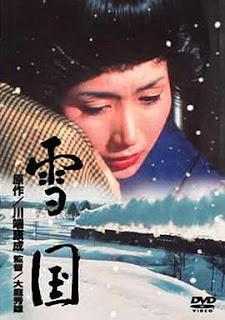69. Góa boeh lâi-khì chò thâu-chang
Shimamura ba̍k-chiu sóa khì khòaⁿ Tē-chông Phô͘-sat: i ū saⁿ-ê tn̂g-tn̂g ê bīn, heng-chêng ū chi̍t-siang ha̍p-chiáng ê chhiú, tò-pêng hām chiàⁿ-pêng mā lóng ū nn̄g-ki chhiú.
"Góa boeh lâi-khì chò thâu-chang." Komako kā Yoko kóng, tō iân chhân-hōaⁿ ǹg chng lih kiâⁿ khì.
Ùi chi̍t-châng chhiū-kut kàu lēng-gōa chi̍t-châng chhiū-kut, iōng tek-ki a̍h chhâ-ki ná tek-ko án-ne pa̍k kúi-ā chàn, kòa koah lo̍h-lâi ê tiū-á tī téng-koân phak-ta, khòaⁿ tio̍h ná chi̍t-chō tiū-chháu khiā-pîn. Che chāi-tē lâng kiò chò "hatte" (its tiū-kè). Shimamura in keng-kòe ê lō͘-piⁿ, peh-sèⁿ mā tng-tih chò tiū-kè.
Ko͘-niû khin-khin ngiú chi̍t-ē chhēng seh-khò͘ ê io, hiat chi̍t-khún tiū-á khí lih, peh koân-koân tī tiū-kè téng ê cha-po͘ tō se̍k-chhiú chih tio̍h, sûi kā hun-chhe, kòa tī kè-á téng. Chit-chióng se̍k-liān, choan-sim, koh ū chiat-chàu ê tōng-chok liân-sòa bô thêng.
Komako ná-chhiūⁿ chhìn kùi-tiōng ê mi̍h-kiāⁿ án-ne, kā tiū-kè téng sûi lo̍h ê tiū-sūi phô͘ tī chhiú lih sìm-sìm leh, kóng:
"Chìn pá-tīⁿ, sī iōng chhiú bong tō khí-mo͘-giang ê hó tiū-á. Hām kū-nî ê chha chìn chē." Yi ba̍k-chiu bui-bui, ná chhiūⁿ tih him-sióng. Chi̍t-tīn chhek-chiáu-á kē-kē ùi thâu-khak téng poe kòe.
Lō͘-piⁿ ê piah téng ū chi̍t-tiuⁿ kū ê chóa-tiâu: "Pò͘-chhân kang-chu hia̍p-tēng. Káu-cha̍p chîⁿ chi̍t-kang, hù hóe-si̍t. Cha-bó͘-kang la̍k-chiat."
Yoko yin chhù mā ū tiū-kè, sī tī khah kē ke-lō͘ ê hûiⁿ-tē hia. Koân-koân ê tiū-kè pa̍k tī mûi-tiâⁿ tò-pêng, iân keh-piah-chhù pe̍h piah hit-chōa khī-á chhiū. Lēng-gōa, hûiⁿ hām tiâⁿ sio-chiap ê ūi, iā-tō-sī hām khī-á chhiū ti̍t-kak oat-kòe mā ū tiū-kè, ē-bīn ū chi̍t-ê ji̍p-kháu ē-sái nùi kòe-khì. Án-ne bē-su sī tah chi̍t-ê pêⁿ-á, m̄-koh khàm ê sī tiū-á, m̄-sī chháu-chhio̍h. Hûiⁿ lih, tī siā khì ê ta-lí-á hām chhiûⁿ-bî thâu-chêng, ō͘-á tián-khui ióng-chòng ê hio̍h. Ū âng lí-hî ê liân-hoe-tî hō͘ tiū-kè cha̍h-tio̍h, khòaⁿ bē-tio̍h.
Kū-nî Komako tòa ê hit-keng niû-á pâng ê thang-á-mûi mā khì hō͘ cha̍h tio̍h.
--
69. 我欲來去做頭鬃
Shimamura 目睭徙去看地藏菩薩: 伊有三个長長 ê 面, 胸前有一雙合掌 ê 手, 倒爿和正爿 mā 攏有兩支手.
"我欲來去做頭鬃." Komako kā Yoko 講, tō 沿田岸 ǹg 庄 lih 行去.
Ùi 一叢樹骨到另外一叢樹骨, 用竹枝 a̍h 柴枝 ná 竹篙 án-ne 縛幾 ā 層, 掛割落來 ê 稻仔 tī 頂懸曝焦, 看著 ná 一座稻草徛屏. 這在地人叫做 "hatte" (its 稻架). Shimamura in 經過 ê 路邊, 百姓 mā 當 tih 做稻架.
姑娘輕輕扭一下穿雪褲 ê 腰, 㧒一捆稻仔起 lih, peh 懸懸 tī 稻架頂 ê 查埔 tō 熟手 chih 著, 隨 kā 分叉, 掛 tī 架仔頂. 這種熟練, 專心, koh 有節奏 ê 動作連紲無停.
Komako ná 像秤貴重 ê 物件 án-ne, kā 稻架頂垂落 ê 稻穗 phô͘ tī 手 lih sìm-sìm leh, 講:
"晉飽滇, 是用手摸 tō 起毛婸 ê 好稻仔. 和舊年 ê 差晉濟." 她目睭 bui-bui, ná 像 tih 欣賞. 一陣粟鳥仔低低 ùi 頭殼頂飛過.
路邊 ê 壁頂有一張舊 ê 紙條: "播田工資協定. 九十錢一工, 附伙食. 查某工六折."
Yoko 姻厝 mā 有稻架, 是 tī 較低街路 ê hûiⁿ 地遐. 懸懸 ê 稻架縛 tī mûi 埕倒爿, 沿隔壁厝白壁彼逝柿仔樹. 另外, hûiⁿ 和埕相接 ê 位, 也 tō 是和柿仔樹直角斡過 mā 有稻架, 下面有一个入口會使 nùi 過去. Án-ne 袂輸是搭一个棚仔, 毋過崁 ê 是稻仔, 毋是草蓆. Hûiⁿ lih, tī 謝去 ê ta-lí-á 和薔薇頭前, 芋仔展開勇壯 ê 葉. 有紅鯉魚 ê 蓮花池予稻架閘著, 看袂著.
舊年 Komako 蹛 ê 彼間娘仔房 ê 窗仔 mûi mā 去予閘著.
--
69
Shimamura looked away, toward the Jizo. It had three long faces, and, besides the hands clasped at its breast, a pair each to the left and the right.
"'I'm going to wash my hair," Komako said to V(lko. She turned and started back along a ridge between the paddies.
It was the practice in the snow country to string wooden or bamboo poles on a number of levels from tree trunk to tree trunk, and to hang rice sheaves head down from them to dry. At the height of the harvest the frames presented a solid screen of rice. Farmers were hanging out rice along the path Shimamura and Komako took back to the village.
A farm girl threw up a sheaf of rice with a twist of her trousered hips, and a man high above her caught it expertly and in one deft sweep of his hand spread it to hang from the frame. The unconscious, practiced motions were repeated over and over.
Komako took one of the dangling sheaves in her hand and shook it gently up and down, as though she were feeling the weight of a jewel.
"See how it's headed. And how nice it is to the touch. Entirely different from last year's rice." She half-closed her eyes from the pleasure. A disorderly flock of sparrows flew low over her head.
An old notice was pasted to a wall beside the road: "Pay for field hands. Ninety sen a day, meals included. Women forty per cent less."
There were rice frames in front of Yoko's house too, beyond the slightly depressed field that separated the house from the road. One set of frames was strung up high in a row of persimmon trees, along the white wall between the garden and the house next door, while another, at right angles to it, followed the line between the field and the garden. With an opening for a doorway at one end, the frames suggested a makeshift little theater covered not with the usual straw mats but with unthreshed rice. The taro in the field still sent out powerful stems and leaves, but the dahlias and roses beyond were withered. The lotus pond with its red carp was hidden behind the screen of rice, as was the window of the silkworm room, where Komako had lived.
--


No comments:
Post a Comment